Best Yogurt for Babies & Toddlers
Medically reviewed and cowritten by Jamie Johnson, Registered Dietitian Nutritionist (RDN), and Lauren Braaten, Pediatric Occupational Therapist (OT).
A comprehensive guide on the Best Yogurt for Babies and Toddlers? Yes, please! Find out when you can start serving yogurt, which brands are the best, the ingredient list breakdown, and how to serve yogurt to your baby and toddler. And as a bonus, you’ll also learn 9 delicious ways to flavor plain yogurt! Great for 6+ months regardless of whether you are doing baby food purees or baby-led weaning.

Yogurt for Babies and Toddlers
Wondering what the best yogurt for your baby is and at what age you can serve it? Confused with all of the options in the grocery store?
I did all the research and made this in-depth guide just for you! 😘
In this post we will cover what to look for in yogurt for baby, a round-up of our favorite brands, the difference between Greek and plain yogurt, a list of dairy-free options, when you can safely introduce yogurt to your baby, how to serve to them as a solid food for baby-led weaning, plus 9 great ways to flavor plain yogurt for your baby and toddler, and so much more!
Phew, that sounds like a ton of info 😰, but I promise I made it as concise and complete as possible… cuz I know you have better things to do than spending hours reading about yogurt.
If you are looking for more easy and healthy recipes for your little one, then be sure to check out my 3-Ingredient Banana Pancakes, Spinach Waffles, Eggs for Baby – 10 Ways, or this delicious Homemade Strawberry Applesauce. You can also find more recipes and information in my best-selling cookbook Little Foodies: Recipes for Babies and Toddlers with Taste.
Yogurt for Baby Video
Watch this video to find out more information and how to easily flavor plain yogurt for your baby and toddler.
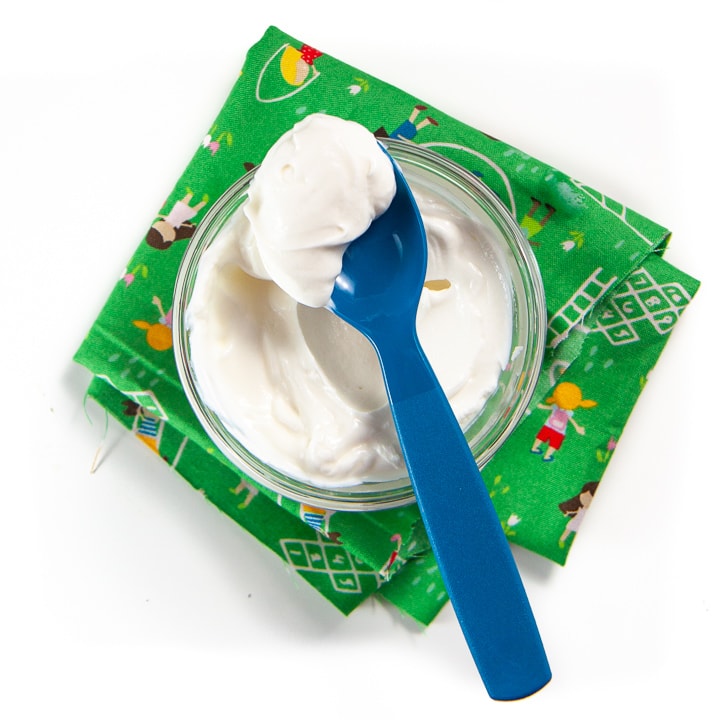
What to Look for in a Yogurt for Baby
When shopping for yogurt for your baby, the ingredient list should be pretty short:
- made with whole milk
- plain or no added sugar
- has a variety of live active cultures
- organic, if possible
Whole Milk (Full-Fat)
Whole milk is important for babies because they need healthy fats to develop muscles and bones. Milk is also one of the most important nutrients for brain development. Babies and toddlers need about 31-35 grams of fat a day (30-40% of total calories), depending on activity level, and most of it comes from healthy fats.
Live Active Cultures
Cultures commonly used in yogurts are L. bulgaricus, S. thermophilus, L. acidophilus, Bifidus, L. casei, and L. rhamnosus. These live active cultures do two things: They make the milk turn into yogurt during the fermentation process, and they also provide the gut with probiotics. Probiotics, or good bacteria, are the good guys helping your baby maintain a healthy gut.
Plain or Unsweetened
Always opt for plain or unsweetened yogurt for your baby and toddlers. Sweetened yogurt can have up to 4 teaspoons of added cane sugar in it, which is way too much for babies and toddlers. You can find 9 fun ways to naturally flavor yogurt below.
Organic (if possible)
Yogurt made from organic milk will be free of synthetic pesticides, artificial hormones, antibiotics, and GMOs, which may be potentially harmful to your baby. Generally, the price difference between organic yogurt vs. standard yogurt isn’t huge — you’ll get an average of $0.14 for an ounce of standard yogurt vs. $0.17 for an ounce of organic yogurt. With all that said, you need to do what’s right for your family and budget.
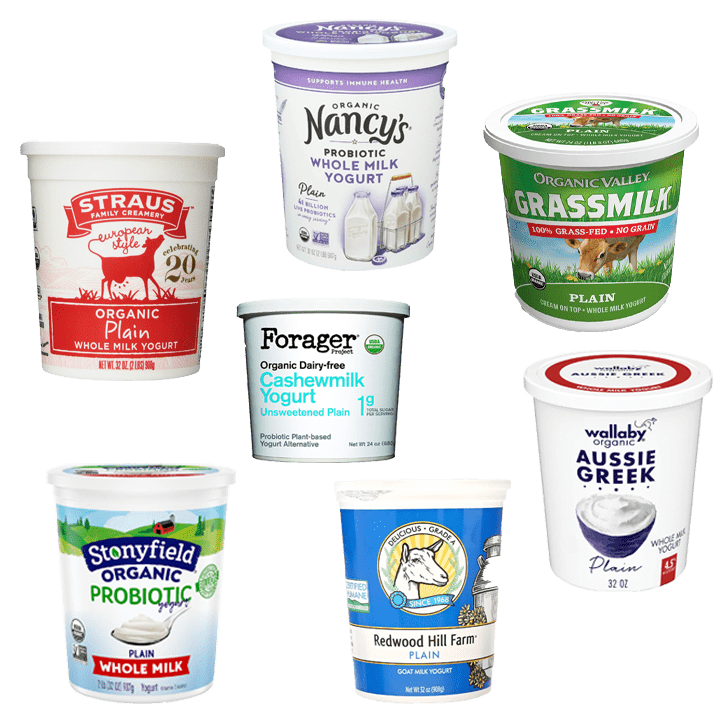
Favorite Brands
Here are some of my favorite brands of yogurt that you can easily find at almost any supermarket. All yogurts taste slightly different, so if your baby doesn’t like one yogurt, you can easily switch to another brand.
Organic Varieties
- Nancy’s, Organic Plain Whole Milk Yogurt
- Straus Family Creamery, Plain Yogurt
- Maple Hill Creamery, Organic Cream on Top Yogurt
- Stonyfield Organic, Whole Milk Plain Yogurt
- Wallaby Organic, Whole Milk Greek Yogurt
Other Varieties
Greek vs. Plain yogurt
Both Greek and standard yogurts are excellent options for your baby and toddlers.
Greek yogurt is strained three times, so it has more protein and a thicker consistency. It also has a more sour taste, which can sometimes be a bit much for some babies or toddlers.
On the other hand, standard yogurt is not typically strained, so it has less protein and a thinner texture. The flavor of standard yogurt is definitely less tart than any Greek variety.
While we generally think that more protein will be better, for young babies and toddlers with still-developing digestive tracts, more protein might be too much for them. Plus, the slightly acidic flavor can be off-putting to some babies and toddlers.
I recommend starting with the standard yogurt and adding Greek yogurt to the menu once your baby is comfortable with yogurt.
Greek yogurt is great:
- for some babies and toddlers
- mixed into purees for babies
- mixed into applesauce for toddlers
- spooned into reusable pouches (makes them thicker, so they don’t drip as much)
- for yogurt parfaits
- for baking
Standard yogurt is great:
- for all babies and toddlers without a dairy allergy
- for smoothies
- mixed into purees for babies
- mixed into applesauce for toddlers
- for baking
- picky eaters
Dairy-Free Options
Plant-based yogurts have grown in popularity in the last couple of years, and I am a huge supporter of serving them to babies, regardless if the baby has a dairy allergy or not. Serving almond, oat, and coconut yogurts to babies will help them gain a wide range of nutrients as well as expand their taste buds. Just like whole milk yogurts, you are looking for dairy-free yogurts that are full of healthy fats (no skim or fat-free) and unsweetened. However, dairy-free yogurts may not provide some of the essential nutrients that dairy varieties provide, like protein and calcium, so make sure your baby is getting those nutrients elsewhere, or the yogurt is fortified.
Favorite dairy-free brands
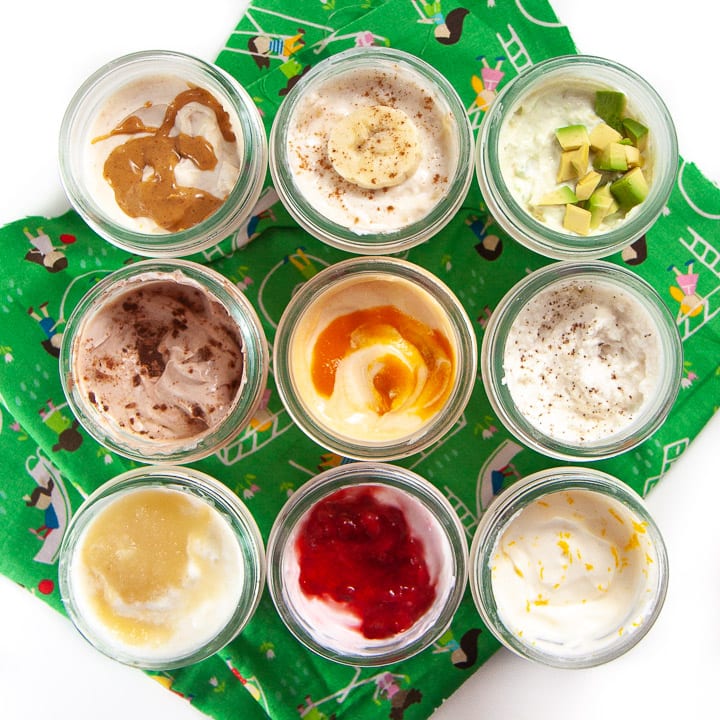
Frequently Asked Questions
You can introduce yogurt to your baby anywhere between 6-8 months of age. Since yogurt is nutrient-dense, I recommend serving it to your baby as one of their first foods but consult your pediatrician if there is someone in the family with a dairy allergy. You may be advised to wait until your baby is closer to 6 months. You can introduce plain yogurt to your baby as is, or you can mix a small teaspoon of yogurt with a baby food puree that your baby is already familiar with.
Can yogurt be baby’s first food?
Dairy yogurt is a common allergen and it is recommended to wait to introduce the top eight allergen foods to your baby once a few other well-tolerated foods have been introduced, especially if your baby is at high risk for food allergies.
Is yogurt a common allergen for baby?
Yes, yogurt made from cow’s milk is one of the most common food allergens, so, as with any food, start with a small portion and be aware of any signs that might be an allergic reaction after introducing it. You may want to talk with your pediatrician about how to safely introduce dairy yogurt if your baby has severe eczema or other food allergies.
Does yogurt cause constipation for babies?
Yogurt may cause constipation in some babies that are sensitive to dairy.
Yogurt for Baby-Led Weaning
Yogurt is still an excellent first food for baby-led weaning. You can simply load up a spoon (this or this one are two of my favorites) and hand the spoon with the yogurt to your baby for them to feed themselves. As they get older, you can place the yogurt into a bowl or sectioned plate and hand your baby the spoon to load and feed themselves.
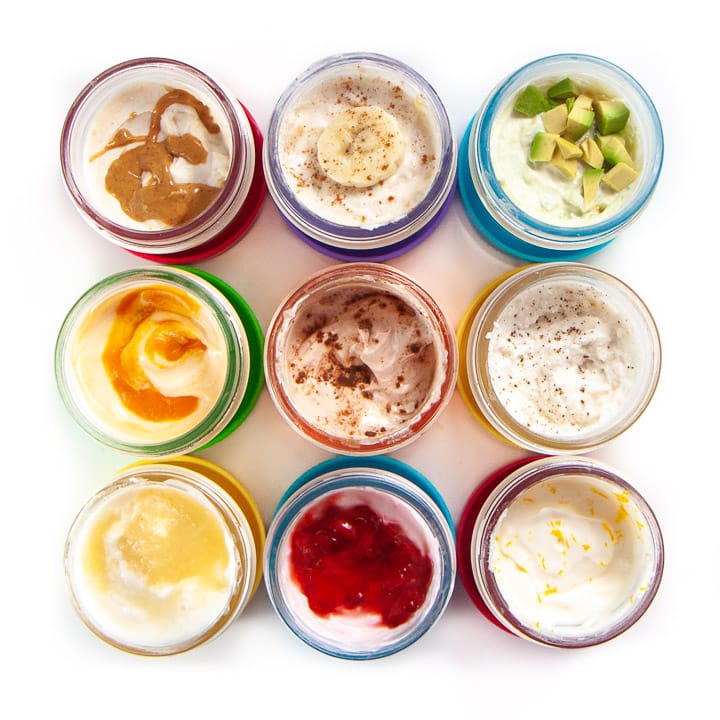
What to Look for in a Yogurt for Toddlers
Finding a great yogurt for toddlers is the same as for babies – you are looking for a plain whole milk (full-fat) yogurt. You can add in fruit, flavors, spices and a touch of sweetener (maple syrup, honey or agave nectar) if your toddler prefers.
Feeding Tips
- Make sure your baby is showing readiness signs for eating – good control of their head and trunk, sitting with minimal assistance, bringing hands or toys to their mouth, and appearing interested in your food when you’re eating.
- Follow your baby’s lead – when feeding purees from a spoon, sometimes there’s a tendency to keep offering bites past the point of your baby being full. Always follow baby’s cues for when they are done eating. Turning away from the spoon, closing her mouth, or pushing food away are all signs that baby is finished with the meal.
- Throwing spoons is a common phase that all babies go through at one point or another. One of the best ways to handle spoon throwing is to ignore it and keep feeding baby as usual (with an extra spoon you already have at the table). If baby ends up also throwing back up spoons #2 AND #3, simply encourage your baby to eat with their hands until they appear to be finished with the meal.
9 Great Ways to Flavor Plain Yogurt
Here are 9 delicious and fun ways to flavor plain yogurt for both babies and toddlers:
Peanut, Almond, or Seed Butter
Adding nut or seed butter into the yogurt does not only enrich the yogurt with a fun, nutty taste, but it is also a way to gently expose your baby to nuts (read more here about introducing nuts to your baby). You can add a drizzle of maple syrup or honey for a sweeter meal for toddlers over the age of one.
Veggie or Fruit Puree
You can stir in any homemade or store-bought puree into yogurt, which means you literally have endless options on how to flavor plain yogurt. Don’t be afraid to play around and find out what flavor combo your baby likes best!
Applesauce
You can use unsweetened applesauce or an apple puree to give plain yogurt a sweet, fruity taste without adding sugar or honey. Both of my kids love this option.
Mashed Banana and a Pinch of Cinnamon
This one is SO good; it could pass as a dessert. Simply mash some ripe banana, add a pinch of cinnamon, and mix a little yogurt for a luscious option.
Mashed Berries
I have found that using thawed frozen berries gives the yogurt a sweet taste without the extra sugar. I usually thaw my berries and then smash them on a cutting board with the back of a fork before adding them to yogurt. You can use any frozen fruit you have on hand — strawberries, blueberries, blackberries, peaches, cherries, kiwi, pineapple, raspberries, etc.
Cacao Powder
This one is pleasantly and irresistibly delicious. You can even add a drizzle of maple syrup or honey for toddlers over the age of one, and call it a dessert. Note that Cacao powder is different than cocoa powder. Cacao powder isn’t as refined and is considered a superfood. It is high in antioxidants and flavonoids, which makes it an excellent choice for boosting brain functions. Cacao is also higher in protein, fiber, magnesium, and iron than plain unsweetened cocoa powder. However, if cacao isn’t an option, cocoa will also work; just make sure it’s unsweetened.
Avocado
Adding avocado is a fun, appetizing way to amp up the flavor of plain yogurt. You can also serve this combo on a piece of toast sticks.
Oat Baby Cereal
This is an ideal option for babies that love oat cereal. Adding plain whole milk to yogurts makes the cereal even more nutritious with essential fats and nutrients. I also recommend adding a pinch of cinnamon or cloves to make the dish taste more distinct.
Orange Juice and Vanilla
Using freshly squeezed oranges will boost the vitamin C and add a citrus twist to the yogurt. Vanilla extract brings out the flavor of orange juice, but it is optional.
Storage
You can store plain or mixed yogurt (like the recipes above) in the fridge for up to 3 days. You can freeze yogurt in air-tight containers or freezer trays for up to 2 months.
Favorite Recipes
Here are some more favorite recipes on how to serve yogurt to your baby and toddler.
Easy 2-Ingredient Yogurt Melts for Baby
Pumpkin, Yogurt + Prune Baby Food Puree
Quick 4-Ingredient Strawberry Yogurt
Peanut Butter Banana Melts for Baby + Toddler
Kid-Requested Yogurt Tubes & Pouches (5 minutes)
Swoon-Worthy Strawberry Yogurt Popsicle
Flavorful Blueberry Yogurt (3-Ingredients)
Kid-Requested Greek Yogurt Muffins (25 Minutes!)
Kid-Requested Fluffy Greek Yogurt Pancakes (15-Minutes)
DID YOU TRY ANY OF THESE FUN YOGURT FLAVORS?
I’D LOVE TO KNOW HOW IT TURNED OUT! LEAVE A COMMENT AND A ⭐️ RATING BELOW 👇

Get the recipe: Best Yogurt for Babies & Toddlers (guide, recipes & more!)
Ingredients
Base Yogurt
- 1/4 cup plain whole milk yogurt
- plus one or more add-ins from below
Add-Ins
- 2 tsp peanut, almond or seed butter
- 2 ounces veggie or fruit puree, homemade or store-bought
- 3 tbsp applesauce or apple puree, unsweetened
- 3 tbsp mashed banana and pinch of cinnamon
- 3 tbsp mashed berries, frozen and thawed berries are sweeter
- 1 tsp cacao powder
- 2 tbsp mashed avocado
- 2 tbsp baby cereal of choice
- 1 tbsp orange juice and a splash of vanilla extract
Instructions
- In a small bowl, mix together the ingredients you wish to flavor the yogurt with until smooth.
Notes
Did you make this recipe?
Tag @babyfoode on Instagram and hashtag it #babyfoode!

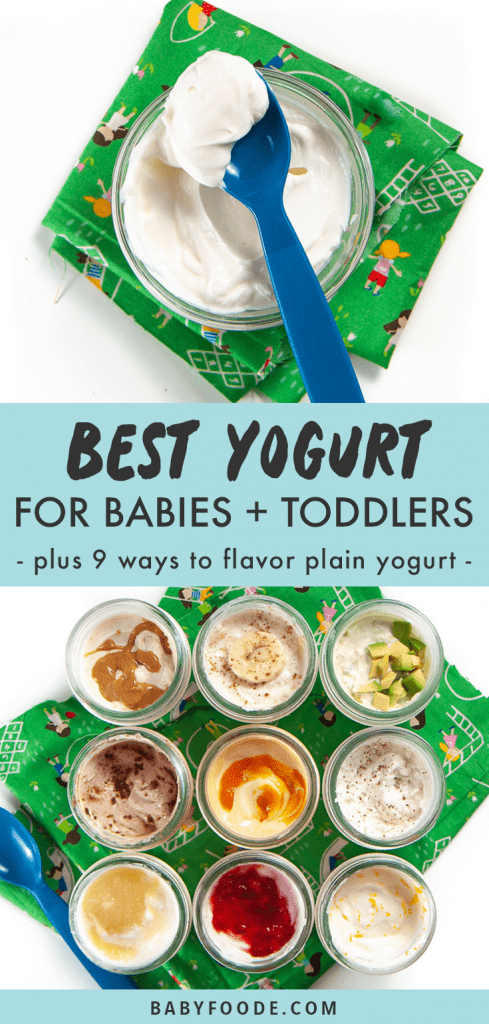

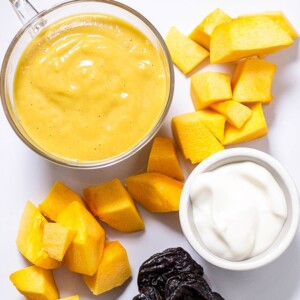
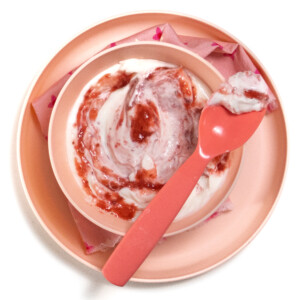
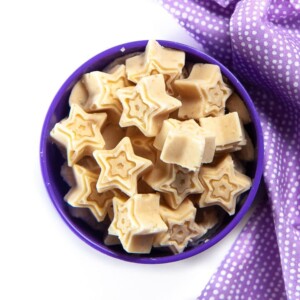
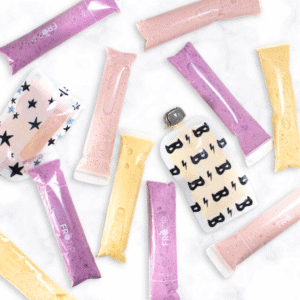
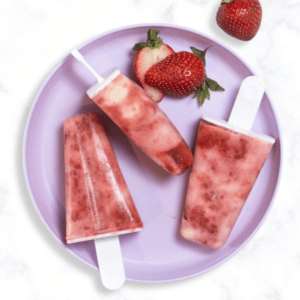
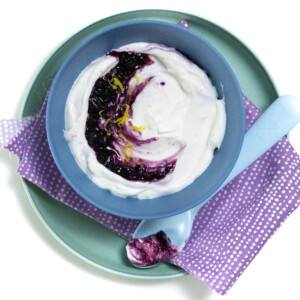
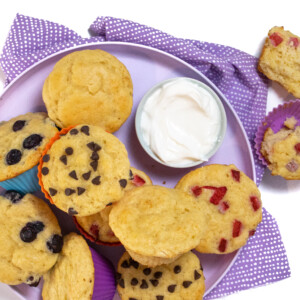
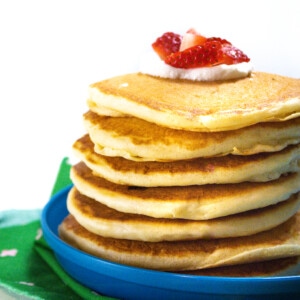
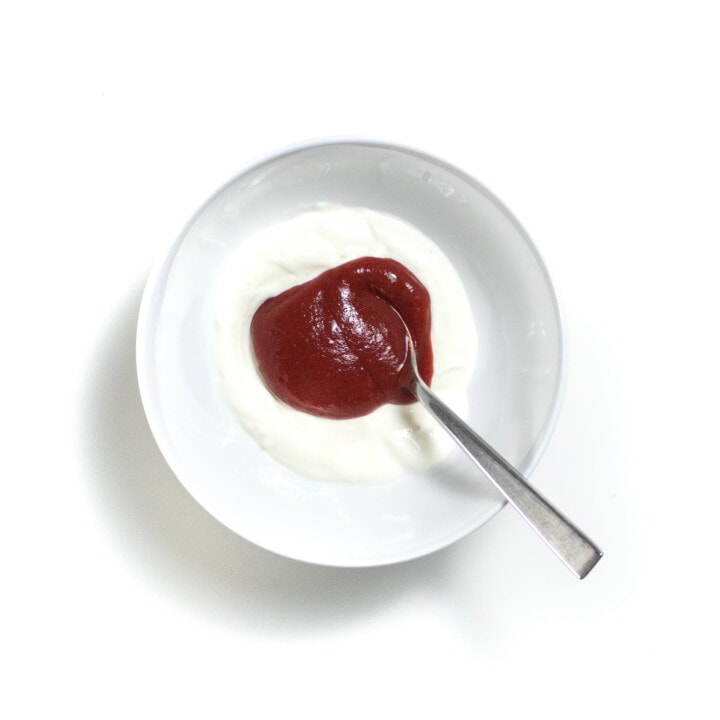
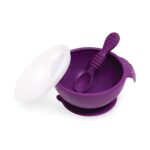

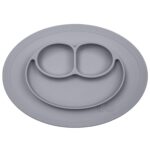
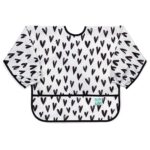

23 Comments on “Best Yogurt for Babies & Toddlers”
Very versatile and nutritious options.
Thank you!
I’m new at making homeade baby foods. I will try these great yogurt recipes.
Thanks 🙋
So happy you found this helpful!
You are amazing and kind. Thank you for sharing these great recipes. We have been enjoying them and he loves it 🙂
My baby likes both plain and Greek yoghurt..
He started enjoying it from 5 months old and now he 10 months…
Its really a super food…
He only likes it mixed with banana and nothing else oops… But prefers it not mixed with anything really. He can eat as much as given to him.
So glad your little one likes yogurt!
Didn’t start feeding my baby yoghurt until he turned one year. is this ok? I feel like I have messed up 🙁
That is completely okay! Don’t worry about it. They can still get the benefits of yogurt when they are toddlers and kids. You are doing a great job!
Excellent information! Thank you for all the sharing!!
So glad it was helpful!
All of your recipes are just amazing! Nutritious, money saving, and tasty. Thank you for your time In developing such great recipes for our little ones!
Thank you for sharing so many yogurt options. Yogurt is one of the best sources of nutrition and they have probiotics which improves the gut health as well as immunity. I will try every flavor and see which one my toddler likes the most.
Our toddler and one year old love lemon extract or coconut extract added to their yogurt. We sweeten the plain Greek yogurt slightly with a drop of liquid stevia. We also hide a small amount of superfood powder that you mentioned in another post years ago. They don’t really notice the green if you put it into a reusable pouch. Great options here to add variety, thank you!
I love all of these add-ins!
Whice stores can i buy these yogurts at?
I’m at having trouble finding a whole milk yogurt for baby at my local grocery stores
Hello Goretti,
I can get them at Whole Foods, Target, Sprouts and Trader Joes. The whole milk yogurts typically come in a container that is not a single serving but not as big as the bulk yogurts at the bottom of the fridge. So like a medium container (not sure the ounces). And there is usually only a small selection. Hope that helps,
Michele
Michele,
Do you know if cow’s milk yogurt is ok to introduce first, or is it better to go with goat’s milk based yogurt? TIA
My son loves plain yoghurt. He could eat 8 oz. if I let him. I would add Siggi’s to this list. It has no additives.
Hello Isil,
I forgot about Siggis! That is also a great brand! Thanks for reminding me!!
I love that your little one will eat so much!! Yum!!
xoxo, Michele
What about chobani? We love that kind but not sure if it’s organic?
Our baby hates Greek yogurt, and personally I have to agree with her, but she absolutely loves regular yogurt. I get the Kalona 5% fat cream top and she’s ate it plain from the first time she tried it. We tried Whole Greek because mommy eats Greek but she gagged on it.
Lol!!! I read this comment while I was snacking on Greek yogurt and busted up laughing! At least baby loves one type of yogurt:)
xoxo, Michele